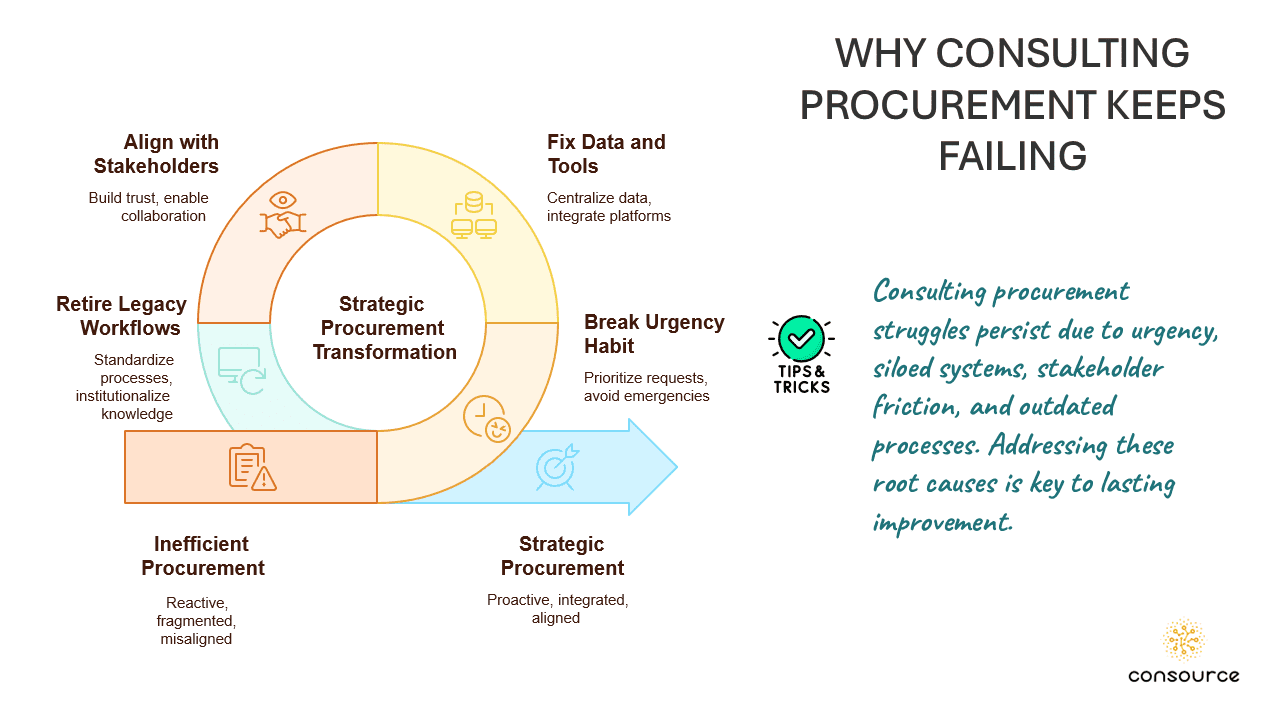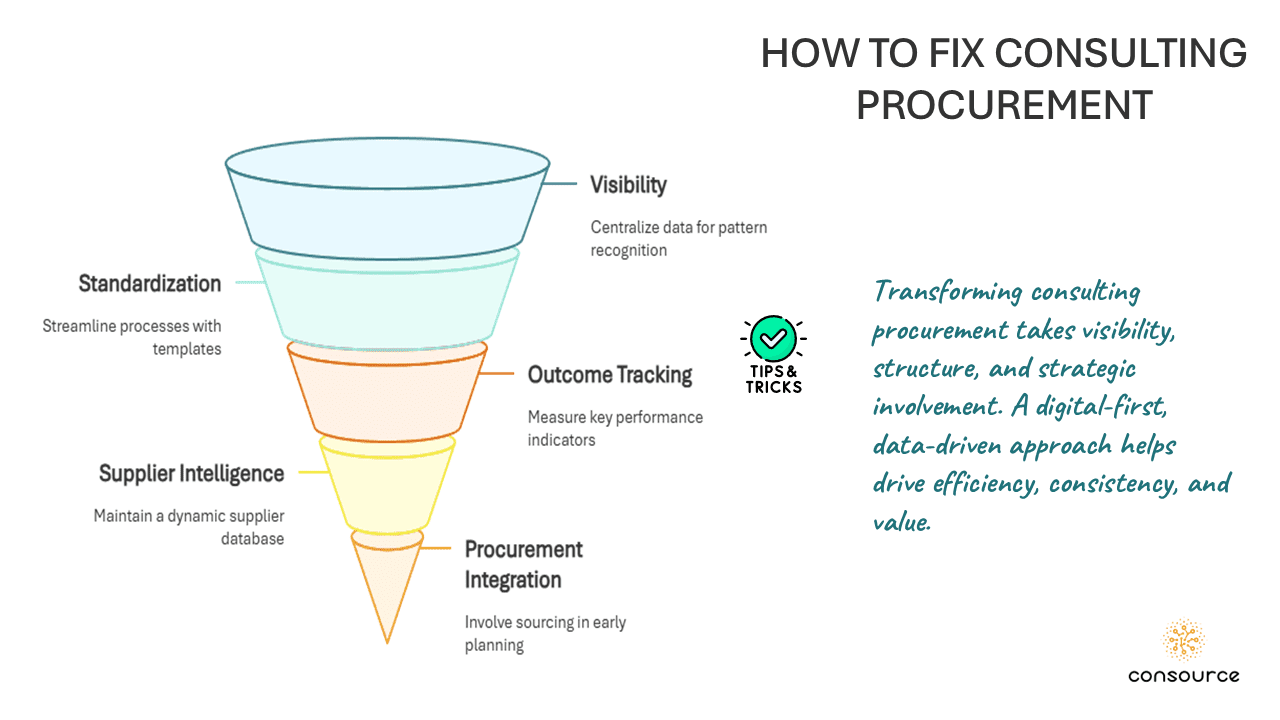Soyons honnêtes. Les défis posés par les achats de services de conseil peuvent donner l'impression que l'ensemble du processus est une boîte noire.
Un instant, vous recevez une demande pour un projet de stratégie de niche en Asie du Sud-Est, et l'instant d'après, on vous demande d'approuver un budget à sept chiffres pour un consultant dont personne n'a entendu parler... et dont le nom a été cité par quelqu'un qui a travaillé avec quelqu'un qui a travaillé un jour chez McKinsey.
Cela vous rappelle quelque chose ?
Vous n'êtes pas seul. Que vous soyez un professionnel expérimenté des achats, un directeur général jonglant avec des priorités concurrentes ou le seul acheteur de services de conseil d'une grande entreprise, vous vous êtes probablement heurté aux mêmes maux de tête récurrents. Les enjeux sont importants : le conseil est souvent l'une des catégories de dépenses les plus coûteuses et les moins transparentes de l'entreprise.
Mais voici la bonne nouvelle : ces défis ? Ils ne sont pas insurmontables. En fait, avec un bon état d'esprit et des outils modernes comme le Consource.ioils sont tout à fait résolubles.
Dans ce guide, nous décrivons les principaux obstacles à l'approvisionnement en services de conseil et, plus important encore, nous expliquons comment les surmonter. Des lacunes en matière de visibilité aux processus fragmentés, nous vous aiderons à transformer les points douloureux en gains de performance.
Parce que le conseil ne devrait pas être un pari. Il doit être un avantage stratégique.
A. L'énigme de la catégorie des services de conseil
Soyons clairs : consulter n'est pas comme acheter des trombones ou des ordinateurs portables.
Lorsque vous êtes services de conseil en matière de sourcingEn effet, il s'agit de quelque chose d'intangible, de coûteux et souvent de politiquement sensible. Contrairement aux produits de base ou même aux systèmes informatiques, la valeur du conseil ne réside pas seulement dans le produit livré, mais dans l'impact qu'il crée, qui est souvent difficile à définir et encore plus difficile à mesurer.
1. C'est Pas un widget, C'est un joker
Les projets de conseil vont du simple exercice d'analyse comparative à la transformation complète de l'organisation. Ils touchent à la stratégie, aux opérations, aux ressources humaines, à la technologie, etc. Et chaque projet est différent. Cette variabilité rend la normalisation presque impossible sans la mise en place de cadres appropriés.
Et n'oublions pas l'élément humain. Vous n'achetez pas seulement de l'expertise ; vous achetez des équipes, de l'alchimie et de la confiance. C'est subjectif, nuancé et souvent influencé par des parties prenantes internes qui ont des opinions bien arrêtées (et des préférences encore plus marquées).
2. Pourquoi les outils traditionnels de passation de marchés ne sont pas à la hauteur
L'un des principaux défis de l'approvisionnement en services de conseil est que les systèmes d'approvisionnement traditionnels ne sont tout simplement pas conçus pour cela. Ils sont optimisés pour des catégories dont les spécifications sont stables et les pools de fournisseurs clairs. Pensez aux fournitures de bureau ou à la gestion de flotte. Le conseil ? Pas vraiment.
Les équipes chargées des achats qui tentent de gérer le conseil à l'aide d'outils génériques se heurtent rapidement à des obstacles :
- Pas de critères de référence standard pour la tarification ou la performance.
- Pas de données cohérentes pour comparer des fournisseurs ou des projets.
- Pas de visibilité de savoir qui achète quoi, quand et auprès de qui.
C'est comme essayer de gérer un orchestre de jazz avec un tableur Excel - vous obtiendrez les notes, mais vous manquerez la musique.
3. Une petite anecdote : Le projet Mystère
Un responsable des achats d'une entreprise du Fortune 500 a récemment découvert un projet stratégique de $1,2 million d'euros qui était passé complètement inaperçu. Pas d'appel d'offres, pas de contrat dans le système, pas d'implication dans les achats. Comment cela s'est-il passé ? Il s'agissait au départ d'un "appel consultatif" avec un cabinet bien connu, qui s'est transformé en un engagement de six mois. Cela vous rappelle quelque chose ?
Il ne s'agit pas d'un cas isolé, mais d'un symptôme de la manière dont les achats de services de conseil fonctionnent aujourd'hui. Elle est fragmentée, opaque et pleine de surprises.
B. Les 5 principaux défis de l'approvisionnement en services de conseil
Si l'approvisionnement en services de conseil avait une personnalité, elle serait charmante et insaisissable, avec un don pour se faufiler dans les processus standard et apparaître sur des factures surprises.
Décortiquons les cinq principaux défis qui rendent la gestion de cette catégorie si difficile, et explorons comment un état d'esprit axé sur le numérique peut transformer le chaos en clarté.

1. Manque de visibilité
Que se passe-t-il ? Qui l'a approuvé ? Et pourquoi est-ce la première fois que vous en entendez parler ?
De nombreuses équipes chargées des achats peinent à obtenir une visibilité sur les dépenses de conseil. Les projets sont souvent lancés directement par les unités opérationnelles, sans supervision centralisée. Les approbations peuvent se faire par courrier électronique, les contrats peuvent se trouver dans la boîte de réception de quelqu'un, et les données sur les dépenses... eh bien, bonne chance pour les trouver en temps réel.
Pourquoi c'est important : Sans une source unique de vérité, vous ne pouvez pas gérer efficacement la demande, consolider les fournisseurs ou évaluer les performances.
Ce qui aide : Des projets centralisés, des tableaux de bord en temps réel et des bases de données unifiées pour les fournisseurs. Lorsque tout le monde parle le même langage en matière de données, le brouillard se dissipe rapidement.
2. Des processus fragmentés
La passation de marchés de conseil est souvent le fruit de processus ponctuels et de solutions de contournement héritées du passé. Chaque département peut avoir sa propre façon de faire : des flux d'approbation différents, des modèles d'appels d'offres incohérents, voire pas de modèles du tout.
Résultat ? Un enchevêtrement d'inefficacités et de nombreuses possibilités d'erreurs - ou pire, d'achats non conventionnels.
Ce qui aide : Des flux de travail normalisés qui permettent néanmoins la personnalisation. Pensez à des pipelines de l'admission au contrat avec des portes de validation intégrées, des accords de confidentialité automatisés et des appels d'offres basés sur des modèles. Plus besoin de réinventer la roue pour chaque projet.
3. Suivi des performances
Soyons réalistes : comment faire pour vraiment mesurer le retour sur investissement d'un engagement stratégique ?
Contrairement aux biens matériels, le conseil ne s'accompagne pas d'une mesure de succès évidente. Trop souvent, l'évaluation des projets repose sur l'intuition ou sur les commentaires des parties prenantes recueillis longtemps après la livraison.
Pourquoi c'est important : Sans indicateurs clairs, il n'est pas possible de tirer des enseignements des projets antérieurs, de récompenser les entreprises les plus performantes ou de les responsabiliser.
Ce qui aide : Définir des indicateurs de performance clés dès le départ - oui, même pour les travaux stratégiques "flous" - et utiliser des examens structurés après le projet. Ajoutez à cela des boucles de rétroaction automatisées et vous aurez la base d'un véritable système de performance.
Si vous vous demandez comment commencer, cet article sur les Mesurer la performance des consultants : Parce que la devinette n'est pas une stratégie commerciale propose une voie pratique.
4. Gestion des fournisseurs
Chaque organisation a ses "favoris" - des entreprises de confiance vers lesquelles les parties prenantes reviennent sans cesse. Mais qu'en est-il des autres ?
L'un des aspects souvent négligés les défis de la passation de marchés de services de conseil est le manque d'informations structurées sur les fournisseurs. La plupart des entreprises n'ont aucune idée de l'identité de leurs fournisseurs les plus performants par catégorie, par zone géographique ou par impact. Et ne parlons même pas des contrôles de conformité ou des vérifications ESG...
Ce qui aide : Construire un répertoire de fournisseurs solide qui suit les capacités, les performances passées, les données sur les risques et les attributs de diversité. Il s'agit d'un banc d'essai dynamique de talents en matière de conseil, et non d'une simple liste de logos.
5. Alignement stratégique
Voici une dure vérité : certains projets de conseil sont davantage axés sur la politique que sur la performance.
Trop d'initiatives sont lancées sans lien clair avec les priorités stratégiques. Les services d'approvisionnement doivent alors se démener pour soutenir des projets qui n'apportent peut-être même pas de valeur ajoutée, ou pire, qui détournent l'attention de ce qui compte le plus.
Ce qui aide : Intégrer les achats dans le cycle de planification stratégique. Lorsque les équipes de sourcing sont impliquées dès le début, elles peuvent aider à hiérarchiser les initiatives, à tester les champs d'application et à orienter les investissements vers ce qui fait avancer les choses.
C. Pourquoi ces défis persistent-ils ?
Maintenant que nous avons exploré le "quoi", attaquons-nous au "pourquoi". Pourquoi les achats de services de conseil restent-ils si difficiles à mettre en œuvre, même dans les entreprises qui ont réussi dans d'autres catégories ?
Attention : ce n'est pas parce que les équipes chargées des achats ne sont pas compétentes. C'est parce que les défis posés par les achats de services de conseil sont particulièrement complexes - les dés sont pipés de manière subtile et moins subtile.

1. La culture de l'urgence
Les besoins en matière de conseil sont souvent urgents. L'ouverture d'un nouveau marché, l'arrivée d'un concurrent ou l'éclatement d'une crise entraînent soudain une ruée vers une aide extérieure.
Les parties prenantes ne veulent pas être ralenties par les formulaires d'inscription, les processus d'approvisionnement ou les examens des marchés publics. Elles veulent que quelqu'un hier. Et soyons honnêtes, cette vitesse est parfois justifiée.
Mais c'est là que le bât blesse : Lorsque l'urgence devient la norme, les achats deviennent une préoccupation secondaire. Ce qui n'était au départ qu'une exception devient une habitude, et la majorité des dépenses passe bientôt inaperçue.
2. Absence de données et d'outils centralisés
La plupart des entreprises gèrent les achats de services de conseil à l'aide d'un ensemble d'outils disparates : des tableaux de suivi Excel, des disques partagés, voire un dossier SharePoint si vous avez de la chance.
Le résultat ? Des données déconnectées, des rapports manuels et une visibilité limitée entre les équipes ou les catégories.
Et parce que le conseil est considéré comme "stratégique", il échappe souvent aux processus structurés appliqués à d'autres catégories de dépenses, ce qui laisse les achats avec peu d'influence et encore moins d'informations.
3. Désalignement avec les parties prenantes de l'entreprise
Ne nous voilons pas la face : de nombreuses unités opérationnelles considèrent encore les achats comme la "police des coûts".
Il existe un fossé historique entre les équipes de sourcing (axées sur l'efficacité et la conformité) et les parties prenantes de l'entreprise (axées sur la rapidité et les résultats). Dans le domaine du conseil, ce fossé peut se creuser rapidement, en particulier lorsque les parties prenantes sont des partenaires de sourcing avec lesquels elles travaillent depuis des années.
Pour combler ce fossé, il faut de la confiance, de la transparence et des outils au service de la société. à la fois côtés.
4. Dépendance excessive à l'égard des processus existants
S'appuyer sur des connaissances tribales, des flux de travail manuels et des modèles incohérents peut fonctionner pour des catégories à faible volume. Mais dans le domaine du conseil, cela conduit à des inefficacités majeures et à une exposition au risque.
Sans système unifié, chaque nouveau projet est un nouveau départ - souvent avec des efforts dupliqués, des leçons manquées et des erreurs évitables.
La solution ? Institutionnaliser les connaissances et normaliser les meilleures pratiques en un seul endroit. Lorsque tout le monde utilise le même manuel, les performances s'améliorent.
D. Comment les surmonter (Sans perdre la tête)
Soyons réalistes : les achats de services de conseil ne vont pas se simplifier comme par magie du jour au lendemain. Mais cela ne signifie pas que vous devez rester bloqué en mode réactif pour toujours. Avec les bons principes et une approche numérique, vous pouvez mettre de l'ordre, de la stratégie et même un peu de bon sens dans le processus.

Voici comment.
1. Commencer par la visibilité
Si vous ne pouvez pas le voir, vous ne pouvez pas le gérer.
Avant d'optimiser les dépenses ou les performances, vous devez avoir une vue d'ensemble de ce qui se passe. En d'autres termes :
- Un système d'admission centralisé pour tous les projets de conseil.
- Une base de données unifiée de contrats, de champs d'application et de profils de fournisseurs.
- Des tableaux de bord en temps réel qui permettent de suivre les dépenses par unité opérationnelle, par zone géographique et par fournisseur.
Une fois la visibilité acquise, des modèles émergent et il devient possible d'agir.
2. Normaliser le processus de recherche de fournisseurs
Chaque projet n'a pas besoin d'être un flocon de neige unique.
Oui, la flexibilité est importante. Mais vous pouvez toujours créer un processus structuré qui fonctionne dans la plupart des catégories de conseil :
- Des modèles d'accueil pour définir clairement les besoins et les objectifs.
- Automatisation des accords de confidentialité et des modèles d'appels d'offres normalisés.
- Définition de flux d'approbation liés à la valeur et au risque du projet.
L'objectif n'est pas ruban rouge-c'est créer de la cohérence pour que les équipes puissent avancer plus rapidement avec les glissières de sécurité.
3. Suivre ce qui compte vraiment
Si votre seul critère de réussite est "les diapositives étaient belles", il est temps de passer à la vitesse supérieure.
Vous pouvez (et devez) mesurer :
- Si le projet a atteint ses objectifs.
- Satisfaction des parties prenantes.
- Respect du budget.
- Impact à long terme sur l'entreprise (s'il est mesurable).
Même les projets subjectifs peuvent être évalués de manière significative lorsque vous définissez des paramètres dès le départ et que vous recueillez un retour d'information structuré après la livraison.
4. Construire un système vivant d'intelligence des fournisseurs
Le choix du fournisseur doit être stratégique et non anecdotique.
Vous avez besoin de plus qu'un Rolodex mental de "firmes que nous aimons". Construisez une vision structurée qui inclut
- Capacités des fournisseurs par catégorie et par région.
- Les performances passées et l'évaluation des parties prenantes.
- Cartes de taux, résultats des projets et données sur les risques.
Ainsi, la sélection des fournisseurs ne se fait plus au hasard, mais à l'aide de données.
5. Intégrer les marchés publics dans la planification stratégique
Plus les marchés publics sont impliqués tôt, plus ils peuvent apporter de la valeur ajoutée.
Au lieu de réagir à des demandes d'approvisionnement de dernière minute, prenez de l'avance :
- Participer à des sessions de planification annuelles ou trimestrielles.
- Aider les parties prenantes à hiérarchiser les initiatives en fonction de leur valeur.
- Conseiller sur les décisions à prendre ou à acheter avant que les projets ne soient délimités.
Lorsque les achats font partie de la stratégie, et pas seulement de l'exécution, c'est toute l'organisation qui en sort gagnante.
E. L'apport de Consource.io
Vous avez vu les problèmes. Vous avez imaginé les solutions. Il s'agit maintenant de les concrétiser.
Consource.io n'est pas un simple outil d'approvisionnement, c'est une plateforme conçue pour s'attaquer aux complexités uniques de l'approvisionnement en services de consultation. Grâce à son expertise en matière de conseil, Consource.io aide les entreprises à passer d'une stratégie d'achat réactive à une stratégie proactive.
Voici comment Consource.io s'y prend pour casser le code :
1. La clarté par la centralisation
Dites adieu au travail de détective.
Avec Consource, tous les projets de conseil - de l'étude exploratoire à la livraison finale - sont suivis en un seul endroit. Les tableaux de bord vous donnent une visibilité instantanée sur qui achète quoi, à qui, pour quel montant et pourquoi. Vous n'avez plus besoin de traquer les dépenses irrégulières ou de passer au crible les feuilles de calcul.
2. Des flux de travail structurés sans bureaucratie
Chaque étape du cycle de vie d'un projet de conseil (acceptation, recherche de fournisseurs, conclusion de contrats, exécution) est intégrée dans des flux de travail personnalisables. Vous pouvez intégrer des modèles, automatiser les accords de confidentialité, appliquer les approbations et rationaliser les appels d'offres sans ralentir les équipes.
Le résultat ? De la cohérence et de la rapidité, et non de la paperasserie.
3. Un suivi des performances qui fonctionne vraiment
Dès le lancement d'un projet, Consource saisit des indicateurs de performance clés, alignés sur les objectifs que vous avez définis. Le feedback post-projet est structuré et automatisé, créant une base de connaissances sur ce qui fonctionne, qui livre et où la valeur a été créée.
Au fil du temps, cela permet de constituer une base de données sur les performances des consultants internes. C'est de l'or stratégique.
4. L'intelligence des fournisseurs au bout des doigts
Consource vous aide à passer des listes de fournisseurs à des portefeuilles dynamiques de fournisseurs. Vous obtenez une vision claire des capacités de chaque entreprise, de ses tarifs, de son historique de livraison, de ses indicateurs de diversité et même de ses indicateurs de risque. Qu'il s'agisse de vous êtes Que vous recherchiez un expert numérique à Tokyo ou un spécialiste de la transformation à Toronto, il vous suffit d'un clic pour trouver la personne qu'il vous faut.
5. Un partenariat stratégique, pas seulement un logiciel
C'est là que le bât blesse : Consource n'est pas seulement une plateforme. C'est un partenaire.
Avec un ADN de conseil intégré et une approche centrée sur le client, Consource donne aux professionnels de l'approvisionnement les outils - et la confiance - pour élever leur rôle. Il vous permet d'influencer la stratégie, d'aligner les dépenses sur les objectifs de l'entreprise et de prouver la valeur de chaque dollar de conseil.
Parce qu'en fin de compte, le conseil en approvisionnement ne se limite pas à la recherche de sources d'approvisionnement, il s'agit de façonner des résultats.
Conclusion : Du chaos au contrôle
L'approvisionnement en services de conseil ne doit pas nécessairement être le Far West de l'entreprise.
Oui, c'est complexe. Oui, elle évolue rapidement. Et oui, il résiste souvent aux manuels traditionnels de passation de marchés. Mais c'est précisément pour cela qu'il vaut la peine d'y remédier.
Les défis de la consultation en matière de marchés publics - Le manque de visibilité, les processus fragmentés, les mesures de performance floues et la mauvaise harmonisation des parties prenantes sont réels. Mais les solutions le sont tout autant. En adoptant un état d'esprit axé sur le numérique, en normalisant là où cela compte et en intégrant les achats au cœur de la stratégie, les entreprises peuvent transformer une catégorie chaotique en un avantage concurrentiel.
Et grâce à des plateformes spécialisées telles que Consource.ioAvec le système de gestion de la sécurité, vous ne vous contentez pas d'éteindre des incendies, vous éclairez la voie à suivre. Vous bénéficiez d'une visibilité, d'un contrôle et d'une performance, le tout en un seul endroit.
Voici donc la question : êtes-vous prêt à cesser de courir après les dépenses de conseil et à commencer à les gérer ?
Réserver une visite guidée gratuite de Consource.io et voyez comment nous pouvons transformer vos performances en matière de conseil. Cliquez ici








0 commentaires